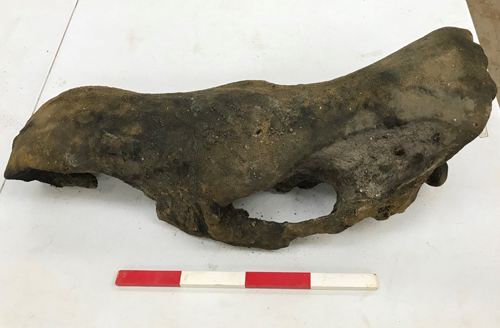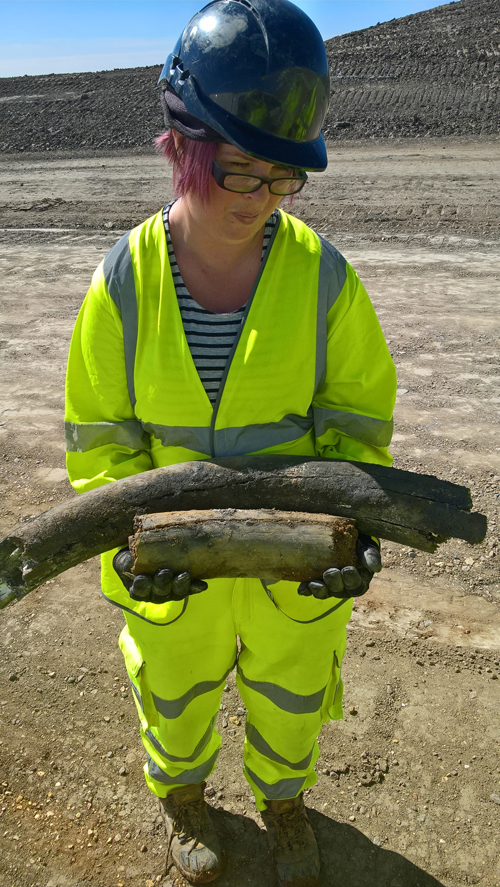Douglas Palmer reports on the recent discovery of Ice Age mammoth and rhino remains near Cambridge
Palmer, D., Mammoth discovery on A14 to Cambridge.
Geoscientist 29 (3), 16-19, 2019
https://doi.org/10.1144/geosci2019-016;
Download the pdf here
For Darren Hickman, a 48-year-old excavator driver from Pontefract, West Yorkshire, it was a once in a lifetime find. Whilst excavating gravel from a pit near Fenstanton, Cambridgeshire, Darren recounts that he “…did a trial load into the base clay level and that’s where I found the first mammoth tusk and the ice age bones.”
Darren was working on the A14 highway improvement programme when his chance discovery soon became headline news across the country. Fortunately, there are systems in place for the onsite recovery of such finds, which can then be rapidly assessed for their scientific importance. In no time at all, Highways England and the contractors MOLA Headland Infrastructure had archaeologist Dr Steve Sherlock and consultant Dr Bill Boismier on site. Bill Boismier, an Ice Age specialist, supplied details that are missing from most of the media reports.
Megaherbivore remains
So far, the recovered bones have been identified as the heavy leg bones of mammoth and rhino, along with a mammoth tusk and partial rhino skulls. These are typical of the large and heavy skeletal remains of the biggest of the Ice Age plant eating animals—the so-called megaherbivores of the time.
 Left, A woolly rhino skull so well preserved that the animal probably lived nearby (credit: Highways England)
Left, A woolly rhino skull so well preserved that the animal probably lived nearby (credit: Highways England)
There is also a suggestion that two different kinds of rhino may be present—the cold-adapted woolly rhino and a warm-adapted steppe rhino. The smaller bones of their skeletons, along with those of smaller animals, were destroyed by the rough and tumble of the huge meltwater rivers that coursed through the region.
It is not unusual for the remains of such animals, which lived in different Ice Age climates, to be jumbled together by river erosion of older sediments and then redeposited with relatively younger sediments. Researchers are currently trying to make exact identifications of the bones and searching the sediments for other clues as to their age.
Dating the remains
The bone-bearing Fenstanton sands and gravels appear similar to those found in the nearby Woolpack Farm Quarry. This quarry preserves a succession of sediments dating from the cold late Wolstonian glacial (from over 130,000 years ago), the warm Ipswichian interglacial (younger than 130,000 years ago), along with much younger features produced between 27-16,000 years ago, during the maximum cold of the last (Devensian) glaciation. However, it is also possible that all the Fenstanton sediments date from Devensian glacial times, which altogether lasted from 115-11,400 years ago. The precise age of the Fenstanton sediments is an important question that researchers are working on now.
Dating sediments is difficult but not impossible thanks to a relatively new and sophisticated technique called optically stimulated luminescence (osl). It is also possible that some relative dates will be obtained from thin organic layers, which occasionally occur within the sands and gravels. Such organic layers are made up of plant remains, such as seeds and pollen in varying states of decay. Many plants are sensitive environmental and climate indicators and, luckily for the researchers, can be identified, even from such remains.
To help with the detailed investigation, a section is going to be opened on one side of the ‘borrow’ pit from which the sediments are being excavated.
This will allow the investigating scientists to systematically sample the different sediments. They will be looking especially at the finer grained sands and organic muds, which were originally laid down in quiet water areas of the Ice Age rivers. Here, they can expect to find more plant remains, the shells of freshwater molluscs and insect remains, especially the tough wing cases of beetles, all of which are potentially useful climate indicators.
 Right, Fragments of mammoth tusk from the A14 excavations (credit: Highways England)
Right, Fragments of mammoth tusk from the A14 excavations (credit: Highways England)
Economic importance
Huge amounts of sand and gravel are required for road building and other construction projects. In the UK, some 15 million tonnes of sand and gravel are sold each year as part of a seven-billion-pound extractive industry. The nearer to the work site sands and gravels can be sourced the better. Cambridgeshire, and East Anglia in general, is a rich source of such materials.
These sands and gravels include the products of glacially eroded and transported rock material, which has been reworked by large powerful rivers that carried huge volumes of glacial meltwater across the region into the North Sea. Along with sediment, the rivers carried the remains of the extraordinary Ice Age bestiary.
Ice Age exhibit
By coincidence, the Sedgwick Museum at the University of Cambridge has an exhibit that tells the story of the latter part of the ‘Ice Age’, and how the life and environments of eastern England were dramatically altered by climate change. The exhibit uses amazing animal and plant remains recovered from historic sites near Cambridge, at Barrington, Barnwell and Burwell, and displays the extraordinary variety of animals that lived in the area. The animals ranged from warm-climate hippos, rhinos, elephant, lion and hyena, to cold-adapted woolly mammoth and woolly rhino. They illustrate the dramatic impact that climate change had on life and environments during a typical interglacial-glacial-interglacial cycle.
It will be fascinating to see how and where the Fenstanton finds fit in to the Ice Age picture.
Douglas Palmer is Communications Officer at the Sedgwick Museum of Earth Sciences, Cambridge; e-mail: [email protected]